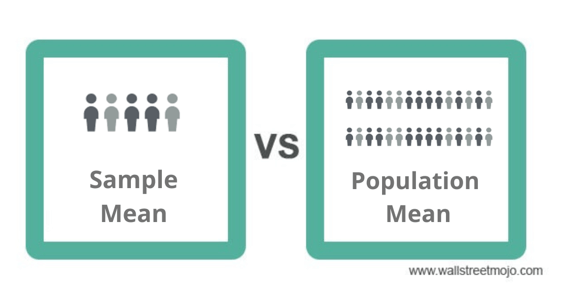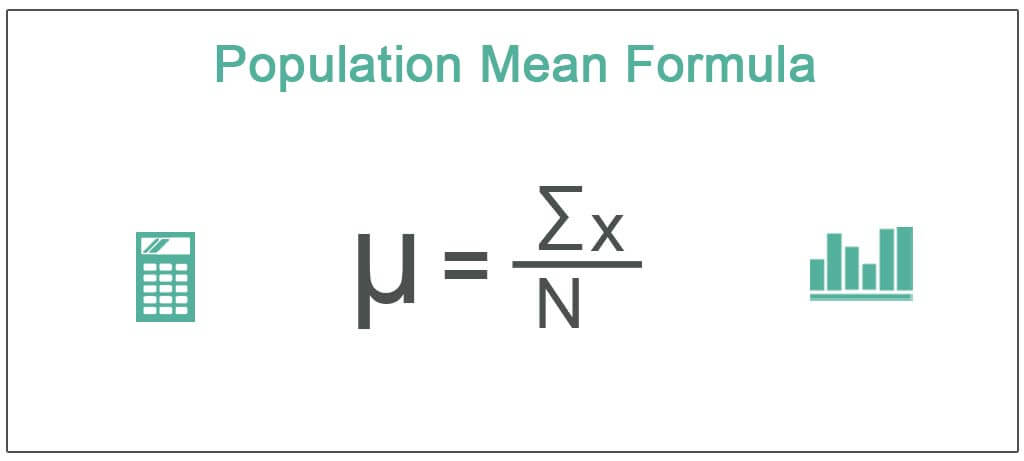Sample Mean Vs Population Mean Differences are as follows:
Table Of Contents
Difference between Sample Mean vs Population Mean
In statistics, there are two different averages: the sample mean and the population mean. The sample mean only considers a selected number of observations—drawn from the population data. The population mean, on the other hand, considers all the observations in the population—to compute the average value.

The method of mean computation is the same in both cases. But, when the population size is large, a sample mean is determined to get an approximate value that represents the entire population. Computing the sample mean is easy, whereas computation of the population mean a tedious process.
Comparative Table
| Basis | Sample Mean | Population Mean |
|---|---|---|
| 1. Meaning | The sample mean is the average of sample values picked from the population. The result resembles the population mean to a certain extent. | Population mean is the central tendency for the entire group. |
| 2. Number of Observations | Compared to the population, the sample size is small. The sample size is represented by 'n.' | The population size is large, and the sample size is denoted by 'N.' |
| 3. Data Source | The sample data is acquired from the population.
| The population data is collected from records, censuses, etc. |
| 4. Calculation | The formula used for the sample mean evaluation is: x̄ =∑xi /n | The formula used for the population mean calculation is: μ=∑X / N |
| 5. Level of Difficulty | For sample mean, data collection and computation are easy. | The collection of population data and computation is a very tedious process. |
| 6. Computed When | The population size is too large or infinite | The population size is small |
| 7. Denoted as | The sample mean is denoted by x bar, i.e., 'x̄'. | Population mean is represented as mu, i.e., 'μ'. |
| 8. Standard Deviation | The standard deviation derived from a sample mean is represented by 's.' | The standard deviation evaluated from the population mean is represented by 'σ'. |
| 9. Accuracy | Since the sample mean considers random sample values taken from the whole population, it may not provide accurate results. | The average calculated for the entire population is accurate and reliable. |
| 10. Statistical Jargon | A sample is a statistic.
| The population is a parameter.
|
What is Sample Mean?
The sample mean is a central tendency measure. The arithmetic average is computed using samples or random values taken from the population. It is evaluated as the sum of all the sample variables divided by the total number of variables.
It is computed using the following formula:
x̄ =∑xi /n
- Here, x̄ is the sample mean.
- ∑xi is the sum of all the sample observations.
- n is the sample size or the total number of observations.
The simple random sampling method is considered unbiased and reliable for determining the sample mean. Simple random sampling is a process where each article or object in the population has an equal chance of getting selected. Thus, It closely represents the result an analyst would have received upon computing the average of the entire population.
Sampling may not always provide the correct result. If a sample represents the population unevenly, it is referred to as a sampling error.
Sample Mean Example
Let us look at an example to understand sample mean calculations:
A preschool authority wants to know the approximate average weight of students. Out of 360 students, 40 students are randomly selected for weighing:
| Number of Students | Weight (Kg) | Number of Students × Weight (Kg) |
| 2 | 14 | 28 |
| 3 | 14.5 | 43.5 |
| 1 | 15 | 15 |
| 1 | 15.5 | 15.5 |
| 3 | 16 | 48 |
| 2 | 16.5 | 33 |
| 4 | 17 | 68 |
| 3 | 17.5 | 52.5 |
| 2 | 18 | 36 |
| 5 | 18.5 | 92.5 |
| 1 | 19 | 19 |
| 4 | 19.5 | 78 |
| 3 | 20 | 60 |
| 1 | 20.5 | 20.5 |
| 5 | 21 | 105 |
| 40 | - | 714.5 |
Clearly, ∑xi = 714.5 Kgs
And, n = 40
Now let us apply the values to the formula:
x̄ =∑xi /n
x̄ = 714.5 / 40 = 17.86 Kgs
Hence, the approximate average weight of preschool students is 17.86 kgs.
What is Population Mean?
A population mean is the average computed from the entire group, distribution, or population. It is derived by dividing the aggregate of all the population variables by the total number of variables in the population.

Population Mean is denoted by the following formula:
μ=∑X / N
- Here, μ is the population mean.
- ∑X is the sum of all the observations in the population.
- N is the population size or the number of total variables in the data set.
When the population size is too large for computation or has an infinite or uncountable number of observations, a sample mean is calculated. This is undertaken using the random sampling method. Also, the sample mean is believed to closely interpret the result of the population mean—if there are no sampling errors.
Population Mean Example
Let us assume that the prices of ABC stock at the end of every trading day for 20 days of a month are as follows:
$15.15, $15.42, $14.91, $14.78, $15.12, $15.56, $15.36, $15.13, $15.31, $14.79, $15.11, $15.31, $15.27, $14.49, $14.77, $14.35, $14.64, $15.21, $15.38, and $15.44.
Now, based on the given data, determine the population mean.
Solution:
μ=∑X / N
μ = ($15.15 + $15.42 + $14.91 + $14.78, $15.12 + $15.56, $15.36 + $15.13 + $15.31 + $14.79 + $15.11 + $15.31 + $15.27 + $14.49 + $14.77 + $14.35 + $14.64 + $15.21 + $15.38 + $15.44) / 20 = 301.5 / 20 = $15.07
Thus, the population mean of ABC stock prices is $15.07.
Sample Mean Vs Population Mean Infographics
Let us look at Sample Mean Vs Population Mean infographics to understand the differences between the two averages better.

Similarities
Sample Mean Vs Population Mean similarities are as follows:
Both are types of the arithmetic mean. Arithmetic mean is a statistical tool that determines the central tendency of a given set of data. Also, the computation methods for both the means are the same. For computing, the sum of all the observations in a given data set is divided by the total number of observations.
Conclusion
- The sample mean is the central tendency acquired from the sample data. The sample data is drawn from the population. Statistically, the sample mean is represented by 'x̄.'
- On the contrary, the population mean is the average value of all the observations in a given population or group. It is represented by 'μ.'
- The sample mean sometimes lacks accuracy due to sampling errors and may not fairly depict the population mean. Even so, it is not always possible to determine the population mean when the population size is too large.
